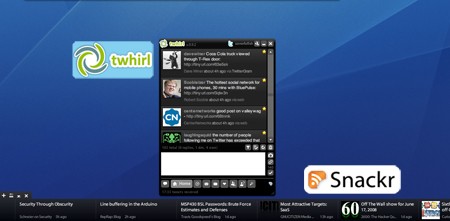
TippingPoint’s Zero Day Initiative reported a critical vulnerability affecting Firefox 3.0 yesterday. It includes the 2.0 versions as well. It’s unreleased and Mozilla is working on a fix already. Whatever the exploit is, it does require the user to visit a malicious site or click a link to executed. It came in 5 hours after the FF3 release, but since it affects previous versions, we wonder if the researcher was just sitting on it to be first. The Zero Day Initiative pays researchers for the exploits they submit.
Month: June 2008
Adobe Air’s Most Install-worthy Apps

Lifehacker has listed the top 10 apps that make installing AIR worth your time and effort. Among them are social networking widgets, RSS readers, and other utilities. As you may know, AIR is a set of cross-platform runtimes that allow developers to create rich internet apps that work on various different operating systems. The runtime environment is just as straightforward to install as any other ( JRE, for example).
Snackr and Twhirl, are both staples here at Hack a Day HQ for tracking news. We’ve also heard good things about Google Analytics Report Suite, which can be really useful for tracking site traffic. Still, we’re inclined to think that our audience could write software that’s at least as creative or useful. If you think you’re up to it, download the Adobe AIR SDK and get crackin’.
SonicWALL Still Hates Us

In case you’ve ever wondered, “why don’t I ever run into those Hack a Day scamps at the Panera?” It’s because SonicWALL thinks we’re a “Hacking/Proxy Avoidance Systems” and the more inexplicable “Usenet News Groups.” We’ve gotten many reports from readers over the years about getting blocked by various vendors’ proxies. Do you have any trouble viewing Hack a Day from your school/work? What “service” are they using? We use ssh’s application level dynamic port forwarding to get around most systems when we’re on the road.
Make Your Own Guitar Pedal With Beavis Board
Beavis Audio has recently released the Beavis Board, a kit to help fledgling guitar pedal builders. The kit addresses four typical problems in this endeavor: learning to solder, dealing with breadboards, sourcing parts, and making sense of schematics. By including a breadboard/psu/switch combo and tons of other parts as well as informative and easy to read schematics, all of these problems are alleviated, allowing eager builders to get to work right out of the box.
The kit costs $249 and we’re guessing it’s a little too “entry level” for most of you. It has a highly informative manual in PDF format. You could use that to get ideas and then source your own parts. Have any of you built a guitar pedal specifically for prototyping?
[via Music Thing]
TR-909 Teardown

Flickr user [firegroove] recently had to take apart his Roland TR-909 drum machine in order to fix it, and he photographed the entire teardown, offering detailed pictures of the TR-909’s internal parts. The TR-909 is legendary as one of the first fully programmable drum machines that could store entire songs, and its legend is only boosted by its scarcity: only 10,000 were ever made. If you can’t afford or simply refuse to tear yours apart, look after the break for a few more photos from inside.
Animatronic Stuffed Animals Stripped Bare

For those who have ever wondered what Chicken-Dancing Elmo’s mechanical parts look like without the fur and the chicken costume (and who among us hasn’t?), [Matt Kirkland] posted the photos above, along with several other animatronic, walking, talking and other mechanical stuffed toys stripped of all their fur and stuffing. These before and after shots were ostensibly taken for unspecified “research purposes,” but if you ask us, any research that takes a knife to Elmo is the most valid kind.
[via Kottke]
High Power LED Blinking Circuit
[youtube=http://www.youtube.com/watch?v=mNDu56oGNck]
Evil Mad Scientist Labs brings us this easy to make LED blinking circuit. The idea is to put a LED in series with a small blinking incandescent bulb from a string of Christmas lights. The bulb has an internal bimetallic strip that bends out of shape when it heats up, cutting the circuit. when it cools enough, it returns to its original shape and closes the circuit again, making the bulb and the LED turn on. Both lights have short period of sustained light when they are initially powered up since the bimetallic strip is still warming up.
The project uses a 5W blue LED, the aforementioned bulb, and a 6V battery pack loaded with 3 AAA batteries. The battery pack and the lights are all attached to a small section of perforated board. Duplicating this project should be easy and provide a very bright LED, but to make a 5W LED shine its brightest, a larger bulb and a heatsink will be necessary.











